![]()
![]()
![]()
Use LEFT and RIGHT arrow keys to navigate between flashcards;
Use UP and DOWN arrow keys to flip the card;
H to show hint;
A reads text to speech;
44 Cards in this Set
- Front
- Back
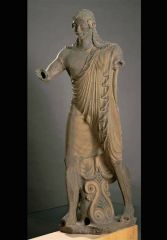
|
Apollo culture: Etruscan date: -- context: Temple of Minerva, Veii material: painted terra cotta Huge figure. Artists had to know how to construct figures so that they didn't collapse under their own weight while the clay was still wet. Also had to regulate heat during firing process. Made in Vulca's workshop. Took skill, timing, and precision. Well-developed body and Archaic smile show that Etruscan sculptors were familiar with the Archiac past. Body covered with rippling cloth, dynamic pose suggesting movement. Sense of energy. |
|
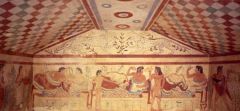
|
Dancers and Diners from Tomb date: -- context: -- material: painted plaster Trees, birds, dancers, reclining couples, cats. Men and women engaging in joyful customs and diversions of human life. Striking painting. |
|
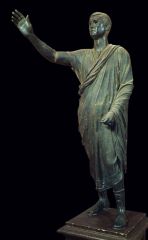
|
Aulus Metellus, the Orator date: -- context: -- material: bronze Man addressing gathered audience. Ad locutio pose expressive of rhetorical persuasiveness. Leather boots and toga are characteristic garments of a Roman senator. Perhaps the statue was mounted in public space as tribute to Aulus' contributions. |
|
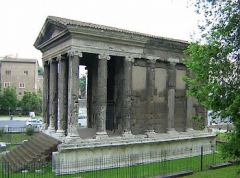
|
Temple, perhaps dedicated to Portunus date: -- context: Rome material: stone Uses the Etruscan system of a rectangular cella and front porch with steps. Roman architects adopted Greek ionic order. Full columns in front and half columns (engaged) in the walls on sides. Continuous frieze in entablature. Overall resembles Greek temple, but with limited interior space and using columns as decoration. |
|
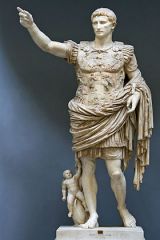
|
Augustus of Primaporta culture: Roman date: Roman Imperial context: Rome material: marble, perhaps copy of bronze statue Merged Plebian Style, Greek, & Roman Republic. Posed similarly to Doryphoros Spear Bearer. Idealized: depicted in youth and strength. Baby cupid (relative) at his feet. Barefoot because he is partially divine. Portraiture was used as propaganda to express authority and leadership. Ad locutio pose (hand up) saying "give me your attention". |
|
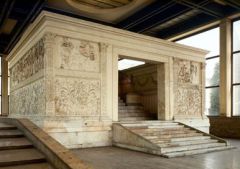
|
Altar of Augustan Peace (Ara Pacis Augustae) with the Imperial Procession culture: Roman date: Roman Imperial (13-9 BCE) context: Rome material: marble The fall equinox caused shadows to extend inside. The exterior is carved in relief in two tiers. Processions similar to the Parthenon. Contains Aeneas Sacrificing A Sow. Portraiture of specific people doing memorable acts. An allegory (image that represents an idea, concept, or principle - often moral or religious). |
|
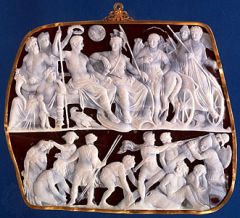
|
Gem of Augustus (Gemma Augustea) culture: Roman date: Roman Imperial context: -- material: onyx Lower register: human realm, in which humans are responding to Tiberias's victory. Armor captured from the defeated enemy is displayed as a trophy. Upper register: divine realm. |
|
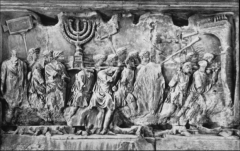
|
Arch of Titus, with Spoils from the Temple of Solomon culture: Roman date: Roman Imperial context: Rome material: marble
arch (barrel vault) which is a passage for a lost bronze statue of the emperor. inscription declares that the senate and Roman people erected monument to honor Titus. |
|
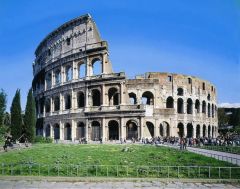
|
Flavian Ampitheater (Coliseum/Colosseum) culture: Roman date: Roman Imperial (70-80 CE) context: Rome material: -- Vespasian took Nero's man-made lake and returned it to the people by building this. It had a velarium above it for shade. Its structure was two Greek theaters pushed together, doubling the architectural benefits. |
|
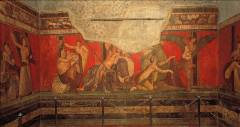
|
Initiation Rites of the Cult of Bacchus in the Villa of the Mysteries culture: Roman date: -- context: Pompeii material: fresco Often performed in private homes, special buildings, or temples. Perhaps this room in the villa was a shrine/meeting place for such a cult to this god of vegetation, fertility, and wine. Bacchus (or Dionysus) was one of the most important deities in Pompeii. Entirely painted architectural setting consists of simulated marble dado and an elegant frieze. Scenes take place on a shallow "stage" along top of dado. Deep red background (Pompeian red). Unfolds around the entire room, perhaps depicting succession of events that lead to the acceptance of a initiate into the cult. |
|
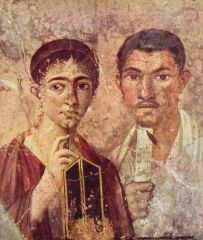
|
Initiation Rites of the Cult of Bacchus in the Villa of the Mysteries culture: Roman date: -- context: Pompeii material: fresco
Often performed in private homes, special buildings, or temples. Perhaps this room in the villa was a shrine/meeting place for such a cult to this god of vegetation, fertility, and wine. Bacchus (or Dionysus) was one of the most important deities in Pompeii. Entirely painted architectural setting consists of simulated marble dado and an elegant frieze. Scenes take place on a shallow "stage" along top of dado. Deep red background (Pompeian red). Unfolds around the entire room, perhaps depicting succession of events that lead to the acceptance of a initiate into the cult. |
|
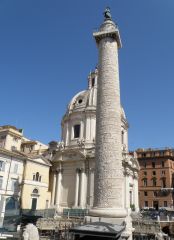
|
Column of Trajan culture: Roman date: Roman Imperial context: Forum of Trajan, Rome material: marble Spirals upward in a 625 ft band. Continuous pictorial narrative of the Dacian campaigns. More than 2500 individual figures linked by landscape and architecture. Bands get larger as distance from viewer increases. Figures occupy most space. |
|
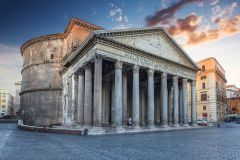
|
Pantheon culture: Roman date: Roman Imperial (118-128 CE) context: Rome material: -- Perhaps most remarkable standing ancient building in Rome. Architectural marvel. Temple to Mars, Venus, and Caesar. Inscribed that it was built by Marcus Agrippa. Viewers had to enter the restricted wiles of the portico and huge main door to enter the giant rotunda (circular room) under a huge dome. Eyes are drawn upward toward coffers in the dome's ceiling. Simple shape, sophisticated design and engineering. Walls punctuated by seven exedrae that originally held statues of gods. |
|
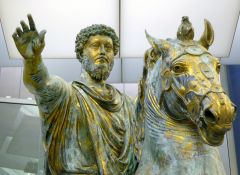
|
Equestrian Statue of Marcus Aurelius culture: Roman date: Roman Imperial context: Rome material: bronze Mistaken as Constantine, so it wasn't melted down. Head of thick curly hair and beard resembles traditional philosopher portraits from Greek world. No armor or weapons, conquers effortlessly by divine will. Reaches out in rhetorical gesture of address. Artist found balance to make rider of horse dominant focus of work. Created model for later artists. |
|
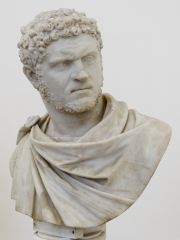
|
Caracalla culture: Roman date: Roman Imperial context: -- material: marble Strong contrasts enhance the intensity of the emperor's expression. Eyes dominate his expression. Caracalla presents himself as a no-nonsense ruler, very determined, with a militaristic haircut and an intense glare. Shows character of new emperors. |
|
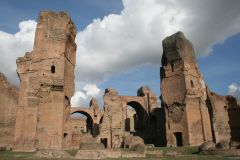
|
Baths of Caracalla culture: Roman date: Roman Imperial context: Rome material: -- Strictly symmetrical plan. Bathing facilities in center of main building to make use of below-ground furnaces for heating. Included exercise rooms, shops, latrines, and dressing rooms. Bath buildings alone covered 5 acres. Entire complex covered 50 acres. |
|
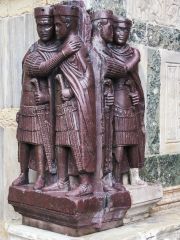
|
The Tetrarchs culture: Roman date: Roman Imperial context: -- material: porphyry A tetrarchy is a rule of four people, nearly identical besides seniors have beards while juniors don't. Made of purple porphyry, extremely hard purple stone reserved for imperial use. It conveys clarity, uniformity, simplicity of organization, and distance from viewer. |
|
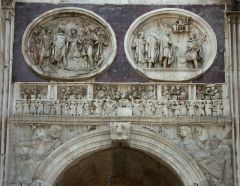
|
Arch of Constantine and Relief Sculpture culture: Roman date: Roman Imperial (early 4th century CE) context: Rome material: marble Commemorates Constantine's victory over Maxentius. Elaborate sculptural decoration and inscription "to the emperor Constantine from the Senate and Roman People". Reused items visually transferred old Roman virtues to Constantine himself. New reliefs were made to recount Constantine's victory in strips consisting of tondi (tondos). |
|
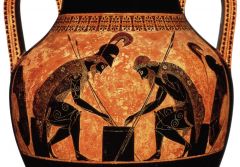
|
Ajax and Achilles Playing A Game, by Exekias culture: Greek date: Archaic context: Athens material: black-figure Ironic that Achilles is winning the game because they will soon go to battle and Ajax will die. Triangular shapes formed. Lines up perfectly with figures in the work. Two warriors very intent on a game. Taking a break from being heroic and they are now humanized and vulnerable. |
|

|
Death of Sarpedon, by Euphronios culture: Greek date: Archaic (6th century BCE) context: Athens material: red-figure Work has 3D depth due to overlapping and contour. Foreshortening used on Sarpedon's leg. Very dramatic, he is pouring blood. Abs show knowledge of human form. Sleep & death raise the slain warrior gently. |
|

|
Warrior culture: Greek date: Early Classical context: Riace, Italy material: bronze Larger than life figure. Pronounced contrapposto pose. Eyes, nipples, teeth, lips, and lashes make it look more realistic. This was a return to the exaggerated form because artists grew bored with realism. |
|
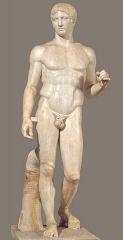
|
Spear Bearer (Doryphoros), by Polykleitos culture: Greek date: High Classical context: Roman copy material: marble Suggested preceding movement. Right arm relaxed on tense leg, left arm tense on relaxed leg. Similar pose to Kritios Boy and Riace Warrior. Polykleitos used mathematics to try to find the perfect balance in his work. |
|
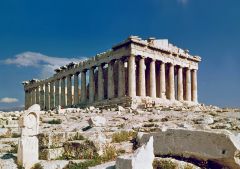
|
Parthenon culture: Greek date: High Classical (447-432 BCE) context: Acropolis, Athens material: marble Took very talented architects, mathematicians, builders, sculptors. 4:9 ratio. Each column a slightly different length. Sloping upward base to make it more visually appealing. Gently swelling columns. Corners strengthened by smaller column spacing. Truly a magnificent work of architecture that researchers today still cannot figure out. Conveys political and ideological themes. |
|
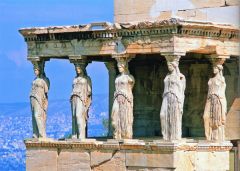
|
Porch of the Maidens (Caryatids) culture: Greek date: High Classical context: Erechtheion, Acropolis, Athens material: marble 6 of them, all in contrapposto pose. The legs they shift their weight on switch half way through (3 left, 3 right). Symmetry and rhythm. South side facing parthenon. Supports ionic entablature. |
|
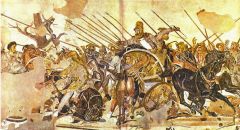
|
Alexander the Great Confronts Darius III culture: Greek date: Late Classical context: Roman copy of Greek wall painting material: mosaic Darius is retreating. Radical foreshortening and diagonal disruption. Violent scene. Overlapping/highlights and shading create a chaotic scene and elicits an emotional response from viewer. |
|
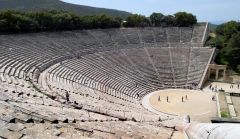
|
Theater culture: Greek date: Hellenistic context: Epidauros material: stone One of the best designs to this day. Allowed for easy entry and exit as well as uninterrupted sight for 12,000 people. Incredible acoustics. |
|
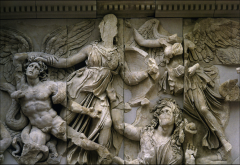
|
Athena Attacking the Giants culture: Greek date: Hellenistic context: Pergamon material: marble Athena grabs the hair of a winged male monster and pushes him to his knees. His mother begs for his life. Nike rushes to crown Athena with a victor's wreath. This work almost breaks out of the borders and protrudes out towards the viewer. |
|

|
Aphrodite of Melos (Venus de Milo) culture: Greek date: Hellenistic context: Melos material: marble Dreamy gaze in eyes. Heavier body proportions. Twisting pose and strong knee projection typical of Hellenistic art. Draping fabric and soft flesh create erotic tension. |
|
|
Etruscans |
controlled north and central Italy (Etruria). Reached peak power when they expanded into the Po River valley and the Campania region. Wealth came from fertile soil and metal ore. Farmers, metalworkers, sailors, merchants, exploited resources in trade. Artists knew and drew inspiration from Greek and Near Eastern art, assimilating influences to create a distinctive style. |
|
|
verism |
verus = true. the style in which artists concern themselves with describing the exterior likeness of an object/person, usually by rendering its visible details in a finely executed manner. (not emotional state, but innate manner). |
|
|
Patricians |
upper class Roman people, privileged families, large landowners
|
|
|
Plebeians |
lower class Roman people, wealth from commerce, became a "middle class" |
|
|
groin vault |
two barrel-vaulted spaces that intersect each other at the same level |
|
|
chiaroscuro |
the use of light/dark to show depth and volume |
|
|
Exedra |
a room with a bench or seats where people can converse, typically semicircular |
|
|
forum |
marketplace of a Roman city, forming the center of judicial and public business. |
|
|
basilica |
large rectangular building with extensive interior space. used for a variety of administrative government functions.
|
|
|
dado |
lower part of a wall, differentiated in some way (by a molding or coloring or paneling) from upper section |
|
|
atmospheric perspective |
details become less distinct as they go further into the distance |
|
|
intuitive perspective |
relies on visual instinct, creates impression of space beyond the wall |
|
|
Trompe l'oeil |
a manner of representation in which artists faithfully describe the appearance of natural space and form with the express intention of fooling the eye of the viewer, who may be convinced momentarily that the subject exists three-dimensionally |
|
|
coffer |
a recessed decorative panel used to decorate ceilings or vaults |
|
|
oculus |
a circular opening, usually as windows or at a dome's apex. |
|
|
cameo |
gemstone, glass, clay, or shell having layers of color, carved in low relief to create an image and ground of different colors. |

